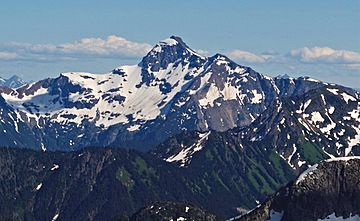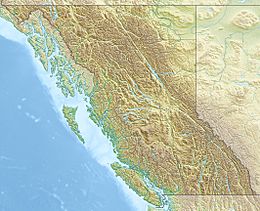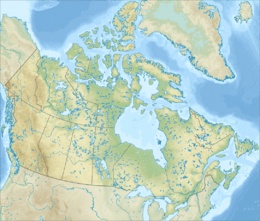Silvertip Mountain facts for kids
Quick facts for kids Silvertip Mountain |
|
|---|---|
 |
|
| Highest point | |
| Elevation | 2,596 m (8,517 ft) |
| Prominence | 1,871 m (6,138 ft) |
| Parent peak | Robinson Mountain |
| Listing | |
| Geography | |
| Parent range | Canadian Cascades |
| Topo map | Skagit River 92 H/3 |
| Climbing | |
| First ascent | 1908 Boundary Survey party |
| Easiest route | West Ridge |
Silvertip Mountain is a tall peak in the Canadian Cascades mountain range. It stands 2,596 m (8,517 ft) high. You can find it south of Hope, in British Columbia, Canada. The mountain sits right on the edge of Skagit Valley Provincial Park.
Silvertip Mountain is very important because of its "prominence." This means how much it rises above the land around it. With a prominence of 1,871 m (6,138 ft), it is one of the fifty most prominent peaks in all of Canada. The name "Silvertip Mountain" became official on December 2, 1948. The first people to climb this mountain were a group from a Boundary Survey in 1908.
How Silvertip Mountain Formed
Silvertip Mountain is connected to something called the Chilliwack batholith. This is a large mass of rock that pushed its way into the Earth's crust about 26 to 29 million years ago. This happened after big mountain-building events in the area. It's part of the Pemberton Volcanic Belt, which is an old volcanic belt that formed when one of Earth's plates, the Farallon Plate, slid under another plate. This process is called subduction and started about 29 million years ago.
During the Pleistocene period, which began over two million years ago, huge sheets of ice called glaciers covered the land. These glaciers moved back and forth many times. As they moved, they scraped away the land and left behind piles of rock. This is why many river valleys in the area are shaped like a "U." The combination of the land pushing up (uplift) and cracks in the Earth's crust (faulting), along with the glaciers, created the tall peaks and deep valleys you see in the North Cascades today.
The North Cascades area has some of the roughest land in the Cascade Range. You'll find jagged peaks, sharp ridges, deep valleys carved by glaciers, and tall, pointed rocks made of granite. All these geological events over millions of years created the different landscapes and big changes in height. These changes also led to different climates, which then created the many types of plant and animal areas, or ecoregions, in this region.
Weather Around Silvertip Mountain
Silvertip Mountain is in a marine west coast climate zone. This type of climate is found in western North America. Most of the weather systems, like storms, start over the Pacific Ocean. They then travel east towards the Cascade Range. When these weather systems hit the mountains, they are forced to rise up. This process is called Orographic lift. As the air rises, it cools down and drops its moisture as rain or snow.
Because of this, the Cascade Mountains get a lot of rain and snow, especially in winter. Temperatures can drop very low, sometimes below −20 °C. With the wind, it can feel even colder, below −30 °C. If you want to climb Silvertip Mountain, the best time to go is usually from July through September. The weather is much better and safer then.



